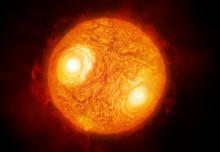Listen to today's episode of StarDate on the web the same day it airs in high-quality streaming audio without any extra ads or announcements. Choose a $8 one-month pass, or listen every day for a year for just $30.
You are here
Moon and Companions
The Moon has a couple of impressive companions this evening. Brilliant Jupiter is to the upper left of the Moon as night falls, with Antares closer to the lower left.
Jupiter is the largest planet in the solar system. But Antares is something even more impressive: a supergiant star. It’s hundreds of times the diameter of the Sun, and tens of thousands of times brighter.
At least it looks that way. We can’t be sure it’s actually still there. A supergiant ends its life with a titanic explosion — a supernova. The blast rips the star to bits, leaving only its tiny, dead core. And astronomers know that Antares is close to the end of its life. In fact, it’s entirely possible that Antares has already exploded but we just don’t know it yet.
That’s because light travels at a limited speed. It’s a really fast speed — 670 million miles per hour. Nothing in the universe can travel faster. Even so, Antares is so far away that its light takes more than five centuries to reach us. So perhaps Antares has already exploded, and the light of the blast is still rushing our way.
Thanks to that finite speed of light, even the Sun could vanish without our noticing it right away. It would take more than eight minutes from the time the Sun vanished until its final light rays reached Earth.
Fortunately for us, the Sun isn’t going anywhere. It’ll remain in the prime of life for billions of years more — shining down on Earth from eight light-minutes away.
Script by Damond Benningfield




